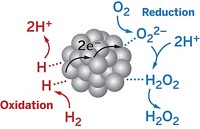Advertisement
Grab your lab coat. Let's get started
Welcome!
Welcome!
Create an account below to get 6 C&EN articles per month, receive newsletters and more - all free.
It seems this is your first time logging in online. Please enter the following information to continue.
As an ACS member you automatically get access to this site. All we need is few more details to create your reading experience.
Not you? Sign in with a different account.
Not you? Sign in with a different account.
ERROR 1
ERROR 1
ERROR 2
ERROR 2
ERROR 2
ERROR 2
ERROR 2
Password and Confirm password must match.
If you have an ACS member number, please enter it here so we can link this account to your membership. (optional)
ERROR 2
ACS values your privacy. By submitting your information, you are gaining access to C&EN and subscribing to our weekly newsletter. We use the information you provide to make your reading experience better, and we will never sell your data to third party members.
Synthesis
Pinning Down A Cobalt-Catalyzed Hydrogen Evolution Mechanism
Water Splitting: Study detects and characterizes elusive reaction intermediate
by Mitch Jacoby
September 7, 2012
| A version of this story appeared in
Volume 90, Issue 37
By designing and using a tailor-made catalyst to slowly mediate electrochemical combination of protons to produce hydrogen, researchers at California Institute of Technology have detected an elusive reaction intermediate and deduced key steps in the mechanism of the hydrogen evolution reaction (Proc. Natl. Acad. Sci. USA, DOI: 10.1073/pnas.1213442109).
The investigation may offer new strategies for designing fast-acting, inexpensive catalysts that tap electrical energy to liberate hydrogen from water. Such electrocatalysts may be incorporated into future devices that convert solar energy to electrical energy, which in turn splits water into O2 and H2. H2 can be stored as a source of carbon-free chemical energy.
Several synthetic transition-metal complexes, including ones based on cobalt, have been shown to be adept at facilitating the proton-combining step. Researchers have proposed a variety of mechanisms that invoke transient cobalt species in attempts to sort out the molecular-scale events underpinning that normally rapid process. The fleeting nature of such intermediates makes it challenging to observe them directly.
To probe the reaction mechanism, the Caltech team designed a catalyst, a Co-tris(diphenylphosphino) complex, that mediates H2 evolution slowly enough to allow the processes to be monitored. On the basis of NMR spectroscopy, the team, which includes Smaranda C. Marinescu, Jay R. Winkler, and Harry B. Gray, reports that the key intermediate is a previously undetected Co(III) hydride.
According to Gray, the study shows that electron transfer converts the Co(III) hydride to a Co(II) hydride, which reacts in acid solution to acquire a proton and liberate H2. The work also shows that a competing process, in which two Co(III) hydride complexes react homolytically to split off a molecule of hydrogen, proceeds far more slowly than the Co(II) protonation step.
“This study provides new insights into the mechanism of cobalt catalysts for hydrogen production,” says Sharon Hammes-Schiffer, a chemistry professor at the University of Illinois, Urbana-Champaign. She notes that the novel aspects of this study are the characterization of the transient Co complex and a kinetics analysis that reveals two competing pathways. “The mechanistic insights gained from this work are likely to assist in the design of more effective catalysts for hydrogen production,” she adds.






Join the conversation
Contact the reporter
Submit a Letter to the Editor for publication
Engage with us on Twitter